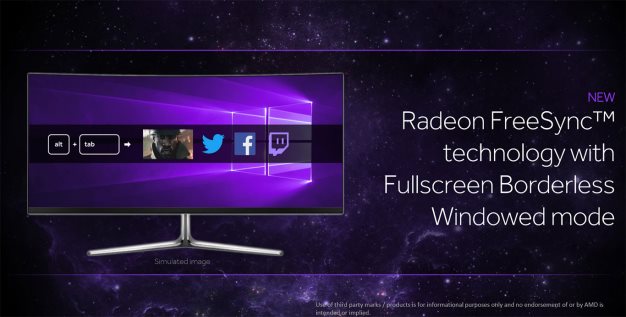AMD Unveils FreeSync 2 Technology With HDR And LFC Support
One of the growing pains associated with FreeSync and its wide-array of compatible displays, is that the experience isn’t always ideal or similar across products. The displays support different maximum and minimum refresh rate targets, and some support low framerate compensation while others do not. With some FreeSync displays, when the framerate falls below the minimum refresh rate supported by the display, animations can get choppy and erratic. LFC can help address that. LFC is automatically enabled with FreeSync, but only when the FreeSync monitor being used has a maximum refresh that is greater than or equal to 2.5 times the minimum refresh rate.
With FreeSync 2, which will be available in a number of upcoming displays in the coming months, AMD and the Radeon Technologies Group are on a mission to reduce latency, improve pixel quality by offering HDR support and better taking advantage of each individual display’s output capabilities, and enhance the experience by requiring support for low framerate compensation in FreeSync 2 certified displays. FreeSync also now supports fullscreen borderless windowed mode.
As it stands today, many monitors are capable of displaying a wider-range of colors and brightness levels than their default configurations allow. And most users set up their display once and rarely re-enter its configuration menus to tailor to individual applications. In addition, applications that support HDR are typically rendered out to an SDR display, which reduces fidelity. HDR 10 and Dolby Vision, for example, offer over eight times the volume of perceivable color and brightness when output properly to compatible displays, which have been tuned properly.
FreeSync 2 addresses this issue in an interesting way. A FreeSync 2 compatible display will provide a compatible game engine with the native characteristics of the monitor that’s attached, and the game will tune its tone mapping to the native capabilities of said display. In addition, FreeSync 2 is also designed to improve the user experience, by enabling an automatic mode switch to the higher-fidelity mode. When a FreeSync 2 enabled game launches, it will automatically switch the monitor’s mode, to make use of the monitor’s full brightness, contrast, and color space capabilities, and will then switch back automatically when swapping to Windows or another application to preserve color accuracy. AMD claims it is typical for FreeSync 2 displays to offer double the perceivable brightness and colors of sRGB, while also offering a better plug and play experience.
FreeSync 2 can also improve input lag because the monitor doesn’t have to spend any time tone mapping for HDR / SDR output. The images coming into the display are already tuned to the specific monitor and won’t require any additional tweaking.
Finally, a display will not get FreeSync 2 certification unless is it low latency and can support LFC. Low framerate compensation is now a requirement with FreeSync 2.
FreeSync 2 will co-exist with FreeSync for now. That may cause some confusion in the marketplace, but AMD felt the improvements in quality and the user experience, in addition to the additional feature support required by the displays, warranted the new branding.





